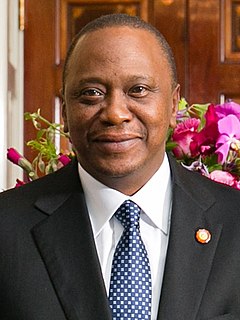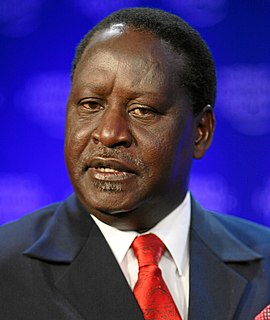
The politics of Kenya take place in a framework of a presidential representative democratic republic, whereby the President of Kenya is both head of state and head of government, and of a multi-party system in accordance with a new constitution passed in 2010.

Uhuru Muigai Kenyatta is a Kenyan politician and businessman who is the fourth and current President of the Republic of Kenya. He served as the Member of Parliament (MP) for Gatundu South from 2002 to 2013. Currently the party leader and a member of the Jubilee Party of Kenya, he was previously involved with The National Alliance and before that the Kenya African National Union.

Stephen Kalonzo Musyoka is a Kenyan politician who was the tenth Vice-President of Kenya from 2008 to 2013. Musyoka served in the government under President Daniel arap Moi and was Minister for Foreign Affairs from 1993 until 1998; subsequently, under President Mwai Kibaki, he was Minister of Foreign Affairs again from 2003 to 2004, then Minister of the Environment from 2004 to 2005. He was an unsuccessful candidate in the 2007 presidential election, after which he was appointed as Vice-President by Kibaki in January 2008.

Wycliffe Musalia Mudavadi is a Kenyan politician, who served as the seventh Vice President of Kenya in 2002 and as Deputy Prime Minister from 2008- 2012 May when he resigned officially to join the presidential race. He is the current Party Leader of Amani National Congress (ANC) after decamping from the Orange Democratic Movement (ODM) led by the prime minister Raila Odinga in 2012 where before his resignation he served as the deputy party leader.He was third in the Kenyan general election, 2013.

Raila Amolo Odinga is a Kenyan politician who served as Prime Minister of Kenya from 2008 to 2013, and has served as Leader of the Opposition since 2013. He was Member of Parliament (MP) for Langata from 1992 to 2013. He served in the Cabinet of Kenya as Minister of Energy from 2001 to 2002, and as Minister of Roads, Public Works and Housing from 2003 to 2005. Odinga was appointed High Representative for Infrastructure Development at the African Union Commission in 2018.

A constitutional referendum was held in Kenya on 21 November 2005. Although many government officials, including President Mwai Kibaki, had campaigned for a "yes" vote, the proposed new constitution was rejected by 58% of voters.

George Musengi Saitoti, E.G.H. was a Kenyan politician, businessman and American- and British-trained economist, mathematician and development policy thinker.
John Njoroge Michuki was a Kenyan politician and businessman. He was born at Muguru, village, Iyego Location, Kangema Division in Murang’a District. He was educated in Kenya and abroad. Michuki emerged as one of the prominent and long-serving civil servants and politicians as well as a businessman in Kenya. Michuki served Kenya in various capacities, including Permanent Secretary in the Finance Ministry, Chairman of the Kenya Commercial Bank, Member of Parliament and Cabinet Minister. He was serving his 4th five-year term as a Member of Parliament for Kangema Constituency. Michuki had a reputation as a "ruthless" and efficient manager, and was widely acknowledged as among the best performing ministers in President Kibaki's Government. He was serving as the Minister for Environment and National Resources at the time of his death.
Gideon Moi is a Kenyan politician who has served in the Senate of Kenya, representing Baringo County, since 2013. He was elected with a landslide win of over 80%, trouncing his opponent Jackson Kosgei. He is also the Chairman of the Kenya African National Union (KANU), which for decades was the ruling party in Kenya. He is the youngest son of Kenya's second president, Daniel arap Moi, and Lena Moi.

Martha Wangari Karua is a Kenyan politician. She is a former long-standing member of parliament for the Gichugu Constituency and an Advocate of the High Court of Kenya. She was Minister of Justice until resigning from that position in April 2009. Karua has consistently fought for the protection of women's rights and improvements to the democratic process.
Salim Lone is a Kenyan journalist who was Prime Minister Raila Odinga’s Spokesman (2007-2012), and before that was Director of the United Nations News and Media Division under Kofi Annan at the United Nations, where he worked for two decades until retiring in 2003. His final UN assignment was as Spokesman in Baghdad for the head of the UN mission in Iraq, Sergio Vieira de Mello, who was killed with 21 other colleagues in a terrorist attack at the Canal Hotel in Baghdad. Salim is now is writing a book on Kenya’s political evolution in the post-Moi democratic era. Salim Lone has also been a columnist for the Daily Nation of Kenya (2005-2007), and his commentaries have also been published in numerous international newspapers, including The NY Times, The Guardian and The Independent in the UK, the Washington Post and The New York Review of Books. He has been frequently interviewed by the BBC, Al Jazeera and CNN, including on Newsnight, Inside Story and Larry King Live. Earlier, Lone had been the Editor in Kenya between 1971 and 1982 of the Sunday Post and Viva magazine, the only mainstream media in the Kenyatta and Moi eras which consistently presented the political opposition’s point of view. He is the only Kenyan journalist in independent Kenya to have been prosecuted and convicted in court for his work, Lone had to flee the country in 1982 and his citizenship was subsequently revoked by President Moi for “disloyalty” to Kenya.

General elections were held in Kenya on 27 December 2007, electing the President, National Assembly and local councils.
A list of happenings in 2010 in Kenya:

The International Criminal Court investigation in Kenya or the situation in the Republic of Kenya is an ongoing investigation by the International Criminal Court (ICC) into the responsibility for the 2007–2008 post-election violence in Kenya. The 2007–2008 Kenyan crisis followed the presidential election that was held on 27 December 2007. The Electoral Commission of Kenya officially declared that the incumbent President Mwai Kibaki was re-elected; supporters of the opposition candidate Raila Odinga accused the government of electoral fraud and rejected the results. A series of protests and demonstrations followed, and fighting—mainly along tribal lines—led to many deaths, injuries and displacements.

General elections were held in Kenya on 4 March 2013. Voters elected the President, members of the National Assembly and new Senate, as well as County Governors and Representatives. They were the first elections held under the new constitution, which was approved in a 2010 referendum, and were also the first run by the new Independent Electoral and Boundaries Commission (IEBC).
The inauguration of Uhuru Kenyatta took place 9 April 2013. Kenyatta won 50.07% of the vote in the 2013 presidential election.



















